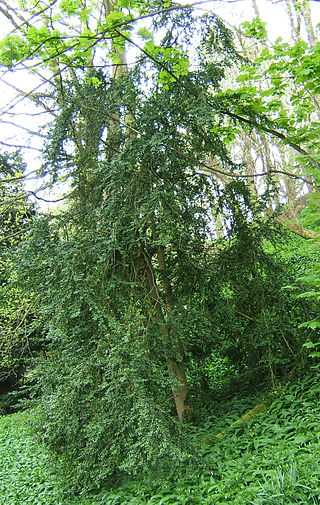
Buxus is a genus of about seventy species in the family Buxaceae. Common names include box or boxwood.

Persicaria maculosa is an annual plant in the buckwheat family, Polygonaceae. Common names include lady's thumb, spotted lady's thumb, Jesusplant, and redshank. It is widespread across Eurasia from Iceland south to Portugal and east to Japan. It is also present as an introduced and invasive species in North America, where it was first noted in the Great Lakes region in 1843 and has now spread through most of the continent.

A knot garden is a garden of formal design in a square frame, consisting of a variety of aromatic plants and culinary herbs including germander, marjoram, thyme, southernwood, lemon balm, hyssop, costmary, acanthus, mallow, chamomile, rosemary, Calendula, Viola and Santolina. Most knot gardens now have edges made from box, which is easily cut into desired shapes, like dense miniature hedges, and stays green during winters when not all of the "filling" plants are visible or attractive. The paths in between are usually laid with fine gravel. However, the original designs of knot gardens did not have the low box hedges, and knot gardens with such hedges might more accurately be called parterres.

Acacia pycnantha, most commonly known as the golden wattle, is a tree of the family Fabaceae native to southeastern Australia. It grows to a height of 8 m (26 ft) and has phyllodes instead of true leaves. Sickle-shaped, these are between 9 and 15 cm long, and 1–3.5 cm wide. The profuse fragrant, golden flowers appear in late winter and spring, followed by long seed pods. Plants are cross-pollinated by several species of honeyeater and thornbill, which visit nectaries on the phyllodes and brush against flowers, transferring pollen between them. An understorey plant in eucalyptus forest, it is found from southern New South Wales and the Australian Capital Territory, through Victoria and into southeastern South Australia.

Cauliflory is a botanical term referring to plants that flower and fruit from their main stems or woody trunks, rather than from new growth and shoots. It is rare in temperate regions but common in tropical forests.

Joseph Henry Maiden was a botanist who made a major contribution to knowledge of the Australian flora, especially the genus Eucalyptus. This botanist is denoted by the author abbreviation Maiden when citing a botanical name.

Acacia, commonly known as the wattles or acacias, is a large genus of shrubs and trees in the subfamily Mimosoideae of the pea family Fabaceae. Initially, it comprised a group of plant species native to Africa and Australasia. The genus name is Neo-Latin, borrowed from the Greek ἀκακία, a term used by Dioscorides for a preparation extracted from the leaves and fruit pods of Vachellia nilotica, the original type of the genus. In his Pinax (1623), Gaspard Bauhin mentioned the Greek ἀκακία from Dioscorides as the origin of the Latin name.

The Australian Botanic Garden Mount Annan is a 416-hectare (1,030-acre) botanical garden located in a hilly area of the southwestern Sydney suburb of Mount Annan, between Campbelltown and Camden, New South Wales. It is the largest botanical garden in Australia, specializing in native plants, with a collection of over 4000 species. Officially opened in 1988, it was known as Mount Annan Botanic Garden, until 2011.

Acacia mearnsii, commonly known as black wattle, late black wattle or green wattle, is a species of flowering plant in the family Fabaceae and is endemic to south-eastern Australia. It is usually an erect tree with smooth bark, bipinnate leaves and spherical heads of fragrant pale yellow or cream-coloured flowers followed by black to reddish brown pods. In some other parts of the world, it is regarded as an invasive species.

Buxus sempervirens, the common box, European box, or boxwood, is a species of flowering plant in the genus Buxus, native to western and southern Europe, northwest Africa, and southwest Asia, from southern England south to northern Morocco, and east through the northern Mediterranean region to Turkey. Buxus colchica of western Caucasus and B. hyrcana of northern Iran and eastern Caucasus are commonly treated as synonyms of B. sempervirens.
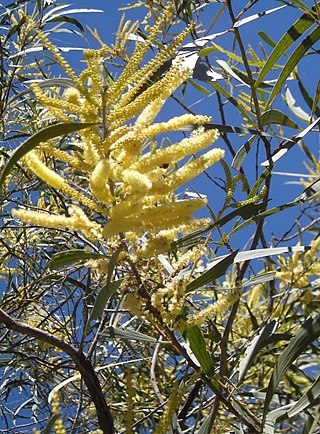
Acacia aulacocarpa, also known as New Guinea wattle or golden flowered salwood, is an Australian shrub or tree in the family Fabaceae. It is found in northern Australia, Papua New Guinea, Irian Jaya and parts of Indonesia.

Encephalartos woodii, Wood's cycad, is a rare cycad in the genus Encephalartos, and is endemic to the oNgoye Forest of KwaZulu-Natal, South Africa. It is one of the rarest plants in the world, being extinct in the wild with all specimens being clones of the type. The specific and common name both honour John Medley Wood, curator of the Durban Botanic Garden and director of the Natal Government Herbarium of South Africa, who discovered the plant in 1895.

Acacia longifolia is a species of Acacia native to southeastern Australia, from the extreme southeast of Queensland, eastern New South Wales, eastern and southern Victoria, southeastern South Australia, and Tasmania. Common names for it include long-leaved wattle, acacia trinervis, aroma doble, golden wattle, coast wattle, sallow wattle and Sydney golden wattle. It is not listed as being a threatened species, and is considered invasive in Portugal, New Zealand and South Africa. In the southern region of Western Australia, it has become naturalised and has been classed as a weed by out-competing indigenous species. It is a tree that grows very quickly reaching 7–10 m in five to six years.

Acacia neriifolia, also known as the oleander wattle, silver wattle or pechy wattle, is a tree in the genus Acacia native to north eastern Australia. It is common in the Moonbi Ranges.
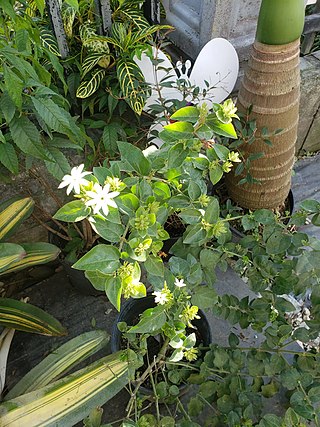
Buxus citrifolia is a species of plant in the family Buxaceae. It is found in Colombia, Panama, and Venezuela. This interesting shrub has not been known to occur in Central America, having only been collected and/or reported in Cuba, Puerto Rico, and Venezuela. Buxus citrifolia is nearly extinct and has been on the endangered list.
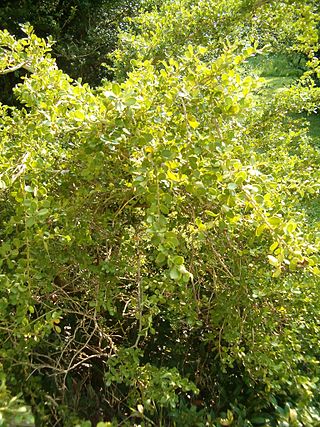
Buxus microphylla, the Japanese box or littleleaf box, is a species of flowering plant in the box family found in Japan and Taiwan. It is a dwarf evergreen shrub or small tree growing to 1 m (3.3 ft) tall and wide.

Encephalartos altensteinii is a palm-like cycad in the family Zamiaceae. It is endemic to South Africa. The species name altensteinii commemorates Altenstein, a 19th-century German chancellor and patron of science. It is commonly known as the breadtree, broodboom, Eastern Cape giant cycad or uJobane (Zulu). It is listed as vulnerable due to habitat destruction, use for traditional medicine and removal by collectors.

Acacia cana, or commonly named as boree or the cabbage-tree wattle or broad-leaved nealie, is part of the family Fabaceae and sub-family Mimosoideae. It is a dense shrub- tree that can grow to 6 metres (20 ft) high and is a perennial plant meaning it has long life span and doesn’t necessary produce a high amount of seed. The cabbage-tree wattle heavily flowers from August till October and relies on animals and insects for pollination and dispersal of seeds. This least concern acacia species is found in the western plains of New South Wales and Central Queensland the habitats of these areas are found to be sandy soils and gibber plains.
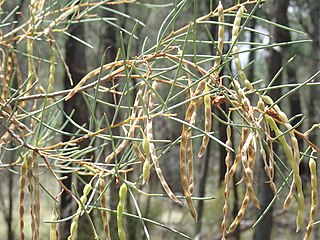
Acacia havilandiorum, also known as Haviland's wattle or needle wattle, is a shrub of the genus Acacia and the subgenus Plurinerves. It is native to areas in South Australia, New South Wales and Victoria.

Buxus sinica, the Chinese box or small-leaved box, is a species of flowering plant in the family Buxaceae, native to central and southern China, Taiwan, South Korea, and Japan. A shrub or small tree, in the wild it is found in a variety of habitats, usually from 600 to 2,600 m above sea level. There are a number of cultivars, all derived from Buxus sinica var. insularis, including 'Winter Gem', 'Green Gem', 'Justin Brouwers', 'Wintergreen', 'Chegu', 'Tall Boy', 'Tide Hill', 'Winter Beauty', 'Green Mountain', 'Pincushion', 'Filigree', 'Green Velvet', and 'Sunny‑side'. In addition to its use in hedging, it is used in bonsai.



















